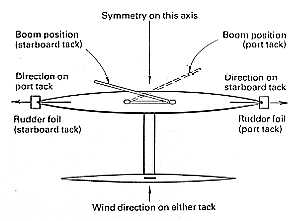This extract comes from "Icarus: the boat that flies" by James Grogono, (ISBN 0229118038) page 53. Images and text © James Grogono.
Leif Smitt is a Danish naval architect who has produced a variety of small hydrofoil projects over the years. He was initially a catamaran sailor and he designed and built a C Class catamaran which won the Little America's Cup from England, at second attempt, in 1968. The rules of the LAC specifically allow hydrofoils, but in Leif's opinion the difficulties of making an all-rounder for a triangular course competition are too great for hydrofoil application. Leif designed and built "Kotaha" for the first Weymouth Speed Week in 1972. She was a proa, reversing her direction of travel when tacking with the main hull always carried to leeward of the outrigger. The single sail of 10 sq m is set on a mast mounted on a sliding track, necessary to preserve the position of the centre of effort when reversing direction.

There were three hydrofoils ; at each end of the main hull were identical units consisting of a 45° dihedral arc-of-circle foil made of solid aluminium, obliquely attached to a vertical rudder unit. The foils are set at zero angle of attack to the water flow, and whichever one is the 'front' is locked in a central position, the unit at the back end being released for steering. The helmsman give the foils a positive angle of attack by moving his weight well aft on a trapeze. The outrigger is supported by a small inverted T foil. Both hull and outrigger were constructed from polystyrene foam sandwiched in glassfibre and expoxy resin. This method of construction was ahead of its time, though it became popular for sailboard construction ten years later and was used by the author in making the high speed board "Dots".

"Kotaha" thus incorporated a handful
of features never tried before, and here sailing qualities were excellent. Unluckily
her hydrofoils were so small that she suffered similar problems to Mayfly in the open
water at the centre of Portland Harbour, and her maximum measured speed of 13.6 knots was
far below her true potential. She was damaged shortly thereafter and has not sailed
again.